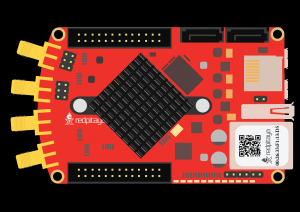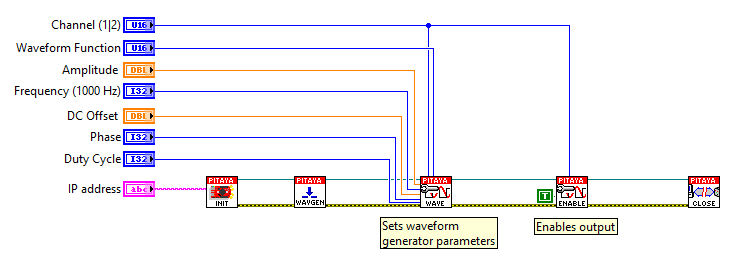2.3.6.3.1. Generate continuous signal
2.3.6.3.1.1. Description
This example shows how to program Red Pitaya to generate an analog 2 kHz sine wave signal with a 1 V amplitude. Voltage and frequency ranges depend on the Red Pitaya model.
2.3.6.3.1.3. SCPI Code Examples
2.3.6.3.1.3.1. Code - MATLAB®
The code is written in MATLAB. In the code, we use SCPI commands and TCP client communication. Copy the code from below into the MATLAB editor, save the project, and hit the “Run” button.
%% Define Red Pitaya as TCP client object
IP = '192.168.178.111'; % Input IP of your Red Pitaya...
port = 5000;
RP = tcpclient(IP, port);
%% Open connection with your Red Pitaya
RP.ByteOrder = "big-endian";
configureTerminator(RP, "CR/LF");
% Reset Generation
writeline(RP,'GEN:RST');
%% GENERATION
writeline(RP,'SOUR1:FUNC SINE'); % Set function of output signal
% {sine, square, triangle, sawu, sawd, pwm}
writeline(RP,'SOUR1:FREQ:FIX 2000'); % Set frequency of output signal
writeline(RP,'SOUR1:VOLT 1'); % Set amplitude of output signal
writeline(RP,'OUTPUT1:STATE ON'); % Set output to ON
writeline(RP,'SOUR1:TRig:INT'); % Generate trigger
%% Close connection with Red Pitaya
clear RP;
2.3.6.3.1.3.2. Code - Python
Using just SCPI commands:
#!/usr/bin/env python3
import sys
import redpitaya_scpi as scpi
IP = "192.168.178.111"
rp_s = scpi.scpi(IP)
wave_form = 'sine'
freq = 2000
ampl = 1
rp_s.tx_txt('GEN:RST')
rp_s.tx_txt('SOUR1:FUNC ' + str(wave_form).upper())
rp_s.tx_txt('SOUR1:FREQ:FIX ' + str(freq))
rp_s.tx_txt('SOUR1:VOLT ' + str(ampl))
# Enable output
rp_s.tx_txt('OUTPUT1:STATE ON')
rp_s.tx_txt('SOUR1:TRig:INT')
rp_s.close()
Using functions:
#!/usr/bin/env python3
import sys
import redpitaya_scpi as scpi
wave_form = 'sine'
freq = 2000
ampl = 1
IP = "192.168.178.111"
rp_s = scpi.scpi(IP)
rp_s.tx_txt('GEN:RST')
# Function for configuring a Source
rp_s.sour_set(1, wave_form, ampl, freq)
# Enable output
rp_s.tx_txt('OUTPUT1:STATE ON')
rp_s.tx_txt('SOUR1:TRig:INT')
rp_s.close()
Note
The Python functions are accessible with the latest version of the redpitaya_scpi.py document available on our GitHub. The functions represent a quality-of-life improvement as they combine the SCPI commands in an optimal order and also check for improper user inputs. The code should function at approximately the same speed without them.
For further information on functions please consult the redpitaya_scpi.py code.
2.3.6.3.1.4. API Code Examples
Note
The API code examples don’t require the use of the SCPI server. Instead, the code should be compiled and executed on the Red Pitaya itself (inside Linux OS). Instructions on how to compile the code and other useful information are here.
2.3.6.3.1.4.1. Code - C API
/* Red Pitaya C API example of Continuous generation on a specific channel */
#include <stdio.h>
#include <stdint.h>
#include <stdlib.h>
#include <unistd.h>
#include "rp.h"
int main(int argc, char **argv){
/* Print error, if rp_Init() function failed */
if(rp_Init() != RP_OK){
fprintf(stderr, "Rp api init failed!\n");
}
/* Reset generator */
rp_GenReset();
/* Generation */
rp_GenWaveform(RP_CH_1, RP_WAVEFORM_SINE); // Waveform
rp_GenFreq(RP_CH_1, 2000.0); // Frequency
rp_GenAmp(RP_CH_1, 1.0); // Amplitude
// Emable channel output
rp_GenOutEnable(RP_CH_1);
// Trigger generation
rp_GenTriggerOnly(RP_CH_1);
/* Releasing resources */
rp_Release();
return 0;
}
2.3.6.3.1.4.2. Code - Python API
#!/usr/bin/python3
import time
import rp
#? Possible waveforms:
#? RP_WAVEFORM_SINE, RP_WAVEFORM_SQUARE, RP_WAVEFORM_TRIANGLE, RP_WAVEFORM_RAMP_UP,
#? RP_WAVEFORM_RAMP_DOWN, RP_WAVEFORM_DC, RP_WAVEFORM_PWM, RP_WAVEFORM_ARBITRARY,
#? RP_WAVEFORM_DC_NEG, RP_WAVEFORM_SWEEP
channel = rp.RP_CH_1 # rp.RP_CH_2
waveform = rp.RP_WAVEFORM_SINE
freq = 2000
ampl = 1
# Initialize the interface
rp.rp_Init()
# Reset generator
rp.rp_GenReset()
###### Generation #####
rp.rp_GenWaveform(channel, waveform)
rp.rp_GenFreqDirect(channel, freq)
rp.rp_GenAmp(channel, ampl)
# Enable output and trigger the generator
rp.rp_GenOutEnable(channel)
rp.rp_GenTriggerOnly(channel)
# Release resources
rp.rp_Release()

